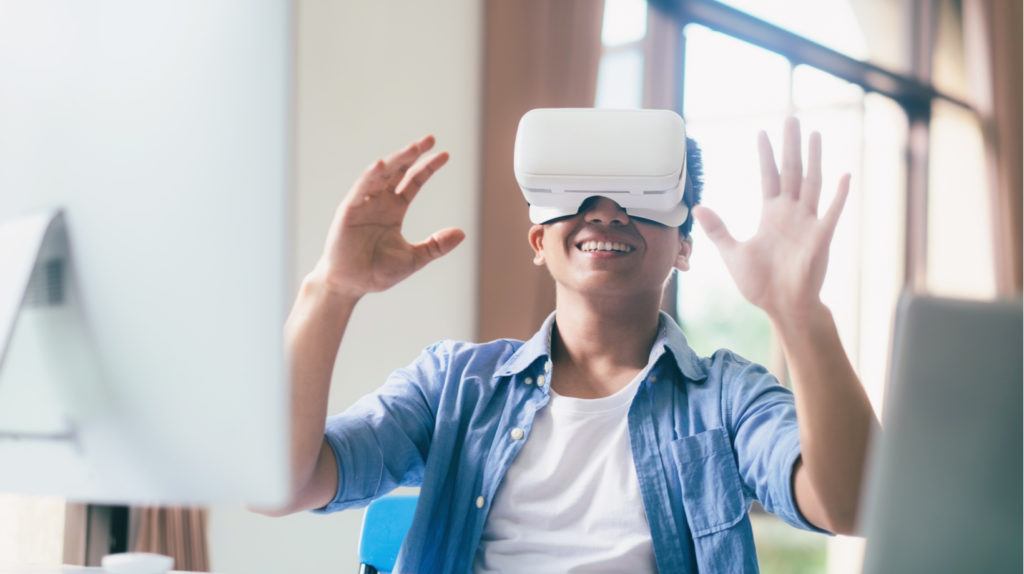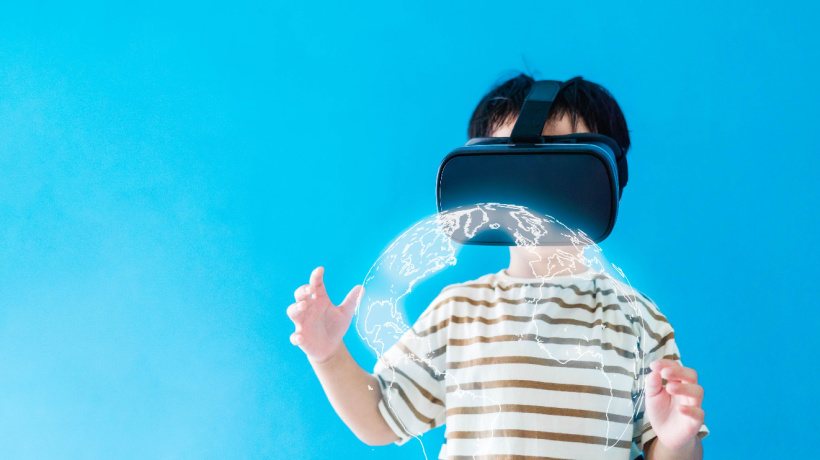Ways VR Enhances eLearning And Improves Skills
Virtual Reality (VR) has the ability to immerse students in a completely different world, where they can walk with dinosaurs, practice giving a speech at a conference or try to order a train ticket in Paris.
Studies have shown that VR can enhance engagement and improve retention; the key metrics that traditional eLearning struggles with. With the prices of VR headsets coming down and the quality of VR educational content increasing, VR has the potential to positively impact how we learn online.
In this article, we propose that a combination of traditional eLearning combined with VR experiences is the most effective way to learn remotely.
An Overview Of Virtual Reality
Overview
Virtual Reality uses computer technology to create a simulated environment for the student. The difference between VR and traditional User Interfaces is that VR puts the student in the experience, where they can manipulate and interact with the 3D world.
VR simulates multiple senses, including vision, hearing, and touch, immersing the student in the artificial world like no other technology. In this way, VR truly immerses students in the learning environment.
VR Headsets
VR headsets are required to experience the VR scenarios and training. There are many options for VR headsets, with cheaper mobile headsets costing as low as $15, up to desktop-based headsets costing around $400.
Students can purchase a mobile-based headset from a local supplier and experience the VR training from any location, at any time. Popular VR headsets for eLearning content include:
- Merge VR
- Blitzwolf VR
- Samsung Gear VR
- Oculus Go
- HTC Vive
How Can eLearning Benefit From VR?
VR Helps Students Learn Through Experience
VR enables students to learn through practical experience, as students are immersed in a world that simulates real-life. Learning through experience has been argued as the most effective way to learn, and studies have shown that it increases the quality of learning and retention by 70-90%.
Through this type of learning, the information is more meaningful, and those who are learning can relate to it because they are applying the information in their own way, through their responses and behaviour.
VR can immerse students in a wide range of scenarios, from exploring the Titanic, to travelling through a human brain, to talking with a press room full of journalists.
Some of the benefits of experiential learning with VR include:
- Accelerates Student Learning
Repetitive learning can be dramatically improved by actually performing or visualising the learning material. - Provides A Safe Learning Environment
When students make mistakes during the learning journey, the consequences are minimal as they occur in a safe and controlled virtual world. - Bridges The Gap Between Theory And Practice
Students learn theory about a certain topic, which they can then experience in an interactive 3D environment, giving students an even more memorable learning experience. - Increases Engagement Levels
The virtual world lets students collaborate and learn from each other, increasing overall engagement.
Social And Collaborative Learning In VR
Good soft skills are an essential part of a successful career. Understanding how to interact with the people around you, in meetings, social events, during networking and more, is crucial to your career progression.
Studies have shown that a lack of human-to-human contact can harm your intellectual development. A BBC article looking at workers shift patterns found that "Working antisocial hours can prematurely age the brain and dull intellectual ability".
Traditional eLearning struggles to incorporate social learning into courses and learning curriculums. Companies, such as FutureLearn, have comment sections for each lecture, where students can interact with each other and ask the lecturer questions. However, this is only surface level interaction with other students on the course.
With VR, students can interact with each other as avatars, where body language, voice and other human aspects come into play.
How Can We Socialise In Virtual Reality?
The social aspect of VR allows students to meet their colleagues virtually, in a similar way to real life. There are several apps already available for this:
- Complete projects and group work together (Bigscreen)
- Travel and explore different locations (Facebook Spaces)
- Attend classes and lectures together (Engage)
Enhancing eLearning with a more immersive social experience lets students interact with each other as they would in a real classroom environment. Students can complete group projects together and socialise outside of class as well, enriching the learning experience.
Examples: VR Currently Being Used With eLearning
VR is already enhancing certain aspects of eLearning. Companies, schools and universities are all experimenting with this new technology and trying to understand how to best fit VR into their learning curriculums. Here are some examples of the technology in action:
Engage Classroom
The ENGAGE VR learning platform allows educators to host classes, private lessons and presentations with people from across the world in a safe, virtual, multi-user environment. Teachers can summon objects in the class, such as a human body and conduct a live virtual autopsy on the body. This helps to bring the learning material to life.
Virtual Speech Training
These soft-skill courses give you an opportunity to practice what you learn in VR. For example, you’ll watch videos and read about how to deliver a presentation to company directors, then get the chance to practice this in a realistic VR boardroom in front of virtual avatars.
Explore The Titanic With Unimersiv
Explore the Titanic in amazing detail with Unimersiv – walk down corridors, enter rooms, discover hidden areas. This tool is currently being used to supplement history lessons in classes around the world.
Future Of VR And eLearning
The future of eLearning will leverage VR to immersive the student in realistic scenarios which help them learn and experience certain topics.
Currently, eLearning is mostly constrained to online videos and articles, with very little learning through experience or immersion. VR changes this as it allows students from anywhere in the world to experience what they are learning. For example, a student might learn about how molecules and atoms work, before putting on a VR headset and being immersed inside an atom and experiencing this first hand.
This hybrid method, where content is learnt through traditional classes and then practiced or experienced in VR, presents a huge opportunity for increased learner retention and engagement.









